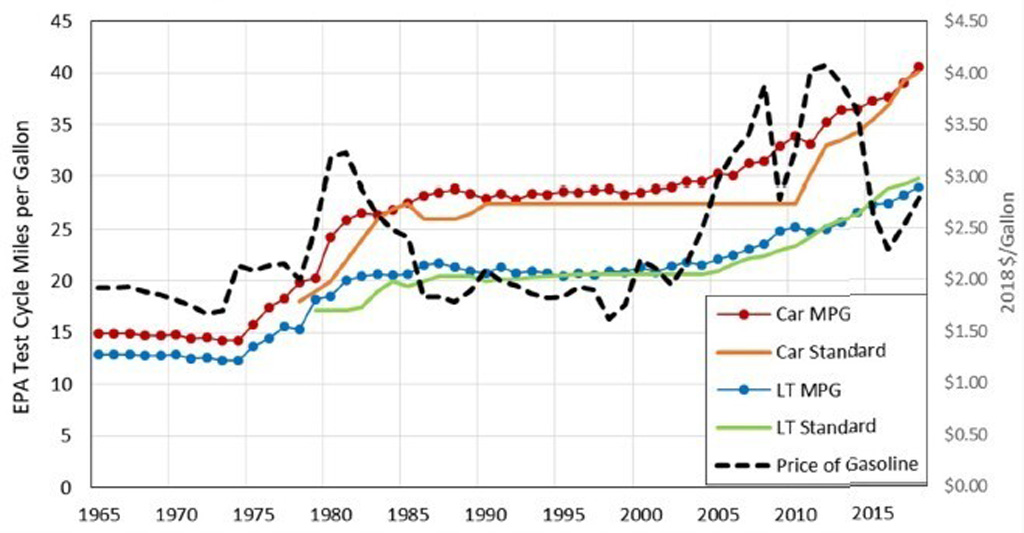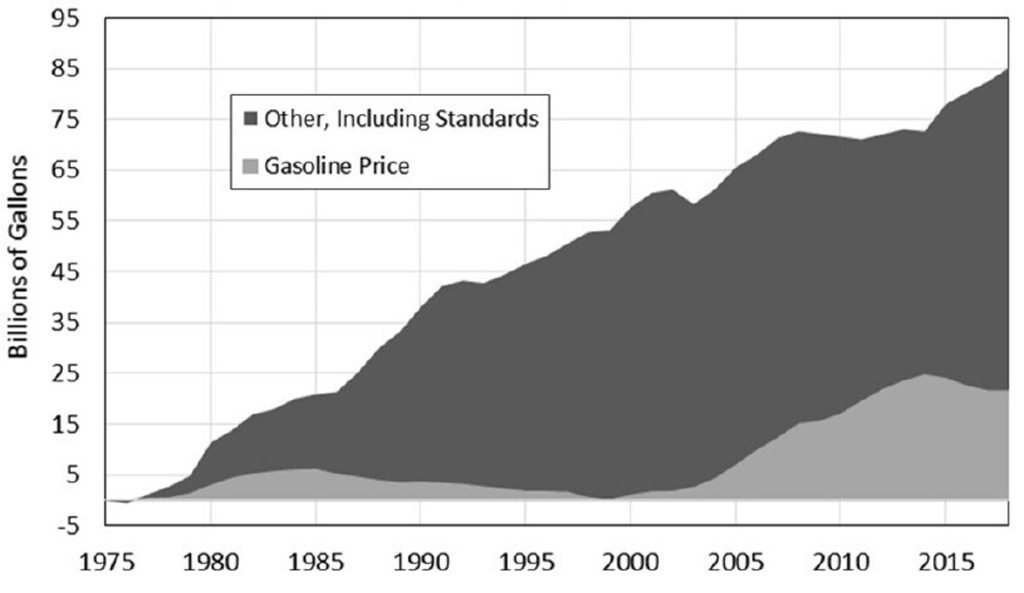
Fuel savings in US cars have ‘cut 17bn tonnes of CO2 since 1975’
Josh Gabbatiss
05.19.20Josh Gabbatiss
19.05.2020 | 8:00amFuel-economy improvements in US “light-duty” vehicles have saved 17bn tonnes of CO2 (GtCO2) over the past four decades, according to a new study.
Cars, vans and light trucks sold in the country today get about twice as many miles to the gallon as 1975 models due to standards that boost performance and cut greenhouse gases.
Combined with rising petrol prices, the analysis suggests these changes amount to savings of 2tn gallons (7.6tn litres) of gasoline – more than the total consumption of these vehicles over the past 15 years.
The research, published in Energy Policy, also concludes that by 2018 these savings amounted to 17bn tonnes of CO2 (GtCO2), with roughly 13.6Gt from new standards alone.
This equates to about three years of emissions from the entire modern US economy.
These results highlight the importance of fuel efficiency as a climate mitigation strategy at a time when the Trump administration is derailing efforts to enhance these standards further.
The paper’s lead author tells Carbon Brief that, other than the conversion of coal power plants to natural gas, no other policy has had such a significant impact on emissions. “Not in this country anyway,” he says.
Saving trillions
At around 28%, transport produces the largest share of US greenhouse gas emissions, with light-duty vehicles – cars, vans and trucks weighing under 8,500 pounds (3,856kg) – making up the most significant chunk of these emissions.
There are 1.2 motor vehicles per licensed driver in the US, but the cars they are using have been getting consistently more efficient for the past four decades.
Lead author Prof David Greene from the University of Tennessee tells Carbon Brief that his research team first wanted to test the link between vehicle efficiency improvements demonstrated in laboratories and changes on the road.
Laboratory tests are known (pdf) to provide overly optimistic estimates of fuel economy, so the researchers adjusted the measurements using methods developed by the US Environmental Protection Agency (EPA), and took into account both the number and age of vehicles over time.
Greene says these tests “matched up very nicely” with real-world improvements estimated by the Federal Highway Administration (FHWA), which are based on traffic counts and fuel tax records. This indicated that fuel-economy improvements tested in the lab correspond well with real improvements to on-the-road fuel economy.
The chart below shows how higher efficiency standards for cars and light trucks (orange and green lines, respectively) have played out alongside fuel economy gains for the two vehicle types (red and blue lines).

Source: Greene et al. (2020).
Next the researchers used the government numbers to determine savings resulting from these improvements to fuel economy and compared them to an alternate reality in which there was no change in vehicle efficiency from 1975 to 2018.
This analysis took into account some complicated knock-on effects resulting from more efficient cars and trucks.
Better fuel economy makes travelling cheaper and can, therefore, incentivise people to drive more, a phenomenon known as the “rebound effect”. This has been widely studied, the researchers note, with the general consensus that a 1% increase in fuel economy causes a 1% increase in vehicle miles of travel – though this effect is declining (more on this below).
Also, without improvements to vehicle efficiency in the US there would likely have been upward pressure on global oil prices as the nation used more gasoline. This, too, was accounted for in the analysis.
While working out CO2 emissions, the team had to account for the phasing in of ethanol into gasoline – a relatively clean additive that can also hamper fuel economy. This began in the 1980s, with most gasoline sold in the US now containing up to 10% ethanol.
Greene notes their calculations are based on the tailpipe emissions of the fuels and not the upstream emissions – for example, from the production of ethanol.
With these factors included in the analysis, the team concluded that improvements in light-duty vehicle fuel economy since 1975 cut more CO2 emissions than from all US sources combined from 2016 to 2018. They also saved society nearly $5tn in fuel costs.
However, in total, Greene estimates that while about 13.6GtCO2 were saved due to policies actively introduced to pursue fuel efficiency and cut greenhouse gas emissions, the rest could have resulted from changes in gasoline price impacting fuel use.
The chart below shows the team’s attempt to attribute volumes of saved fuel to factors such as fuel economy standards, shown in dark grey, versus gasoline price changes, shown in light grey.

Using another alternative scenario based entirely on the changing price of gasoline and a rough estimate that a 10% price rise increased fuel economy by 2-3% in the absence of standards, the team concluded that a fifth of total savings, or about 3.4GtCO2, can be attributed to petrol prices.
Declining rebound effect
Prof Kenneth Gillingham, a Yale University researcher who was senior economist for energy and the environment at the White House Council of Economic Advisers in 2015-16, says that while the paper’s “basic finding could be true”, this is a complicated issue. Gillingham, who was not involved in the study, tells Carbon Brief:
“Attributing things to the standards is tricky since it requires an estimate of what would have happened otherwise, which is tough to say.”
Dr Thomas Klier, an economist at the Federal Reserve Bank of Chicago who has conducted research in this area and also was not involved in the study, tells Carbon Brief the paper is “thorough in its approach” and the central finding of sizable fuel savings is to be expected.
However, he says even the authors acknowledge their attribution of fuel savings to regulatory standards versus the price of gasoline are “educated guesses”.
Greene says their attribution to changing petrol prices was an approximation based on estimates from the literature of the price elasticity of fuel economy, while noting “the world is much more complicated than simple elasticities”:
“On the other hand, I am confident that the great majority of the savings are due to fuel economy and greenhouse gas standards rather than gasoline prices that rose and fell several times and whose predictability has been shown to be not statistically different from a random walk.”
One of the complex factors the paper had to account for is the calculation of the rebound effect, by which cheaper and more efficient fuels encourage car use.
While past studies have considered this value to be constant, recent work suggests it is in fact declining worldwide, particularly in the US, where per-capita income is high, petrol is cheap and population density is low. Greene explains why this could be:
“One, if people’s income is rising, the value of their time increases relative to the cost per mile of fuel, so they make their travel decisions more based on how much their time is worth. The second thing is that as fuel economy improves the fuel cost per mile goes down, so the importance of the cost of fuel in travel decisions decreases.”
For the US in particular, the vehicle market is so saturated and so many people have drivers’ licences that there is little potential for future growth, even if fuel does become substantially cheaper. Greene and his team, therefore, reflect this declining rebound effect in their analysis.
Gillingham agrees generally with this approach, stating that he would use a slightly higher rebound effect, “but not substantially different”.
Trump’s rollback
The paper comes just weeks after the US president Donald Trump completed a rollback of fuel emissions standards adopted under Barack Obama.
The new regulations dictate vehicles must undergo 1.5% increases every year in efficiency until 2026, rather than the 5% annual increase required under existing rules.
Previous analysis by Carbon Brief found this plan could increase emissions from the light vehicles sector by 13%, compared to a scenario where the previous rising standards remain in force.
Greene tells Carbon Brief the new rules are based on “many, many factual mistakes and errors in judgement”, and forgo a strategy that has been shown to both cut emissions and be cost-effective:
“I think it’s the kind of thing you can expect from someone who doesn’t believe that climate change is happening.”
The new rule will face litigation and its impact may be limited as states with stricter standards, such as California, as well as environmental groups and some car manufacturers push back against it.
However, Greene predicts some loss of emissions mitigation potential in the US, “even under the best of circumstances” and even if the upcoming election sees a change in administration.
Luke Tonachel, director of the clean vehicles and fuels group at the Natural Resources Defense Council (NRDC), tells Carbon Brief the new research confirms the power of fuel efficiency standards to cut emissions.
“In fact, they have been the single largest action the US federal government has taken to address climate change…Sadly, the Trump administration wants to ignore the findings of its own EPA – and these outside researchers – and gut the clean car standards. As this research shows, that’s a huge mistake.”
Greene, D. et al. (2020) Two trillion gallons: Fuel savings from fuel economy improvements to US light-duty vehicles, 1975–2018. Energy Policy, doi.org/10.1016/j.enpol.2020.111517

